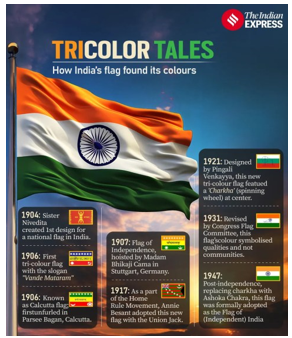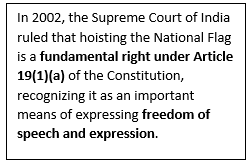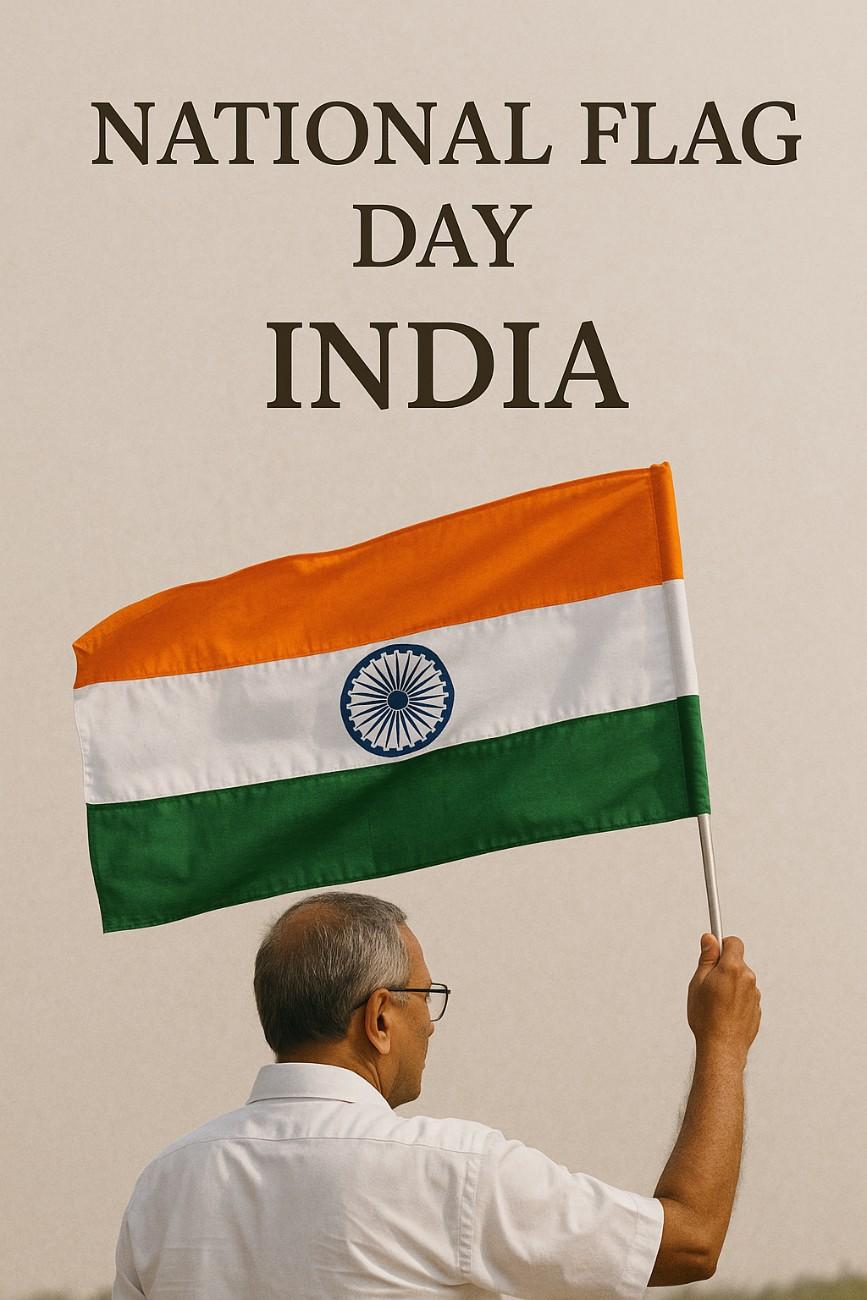Syllabus
GS 1: Freedom Movement
GS 2: Polity and Governance
Context:
In India, July 22 is celebrated as National Flag Day marking a pivotal moment in India’s journey of independence.
More on the News
- India’s Constituent Assembly adopted the National Flag on July 22, 1947.
- The adoption of the tricolour was a key moment in India’s path to becoming an independent nation, free from colonial rule.
Early Beginning

- During the early years of India’s freedom struggle, there was a growing need for a common national flag.
- In 1904, Sister Nivedita proposed a design with red and yellow colours to represent victory and strength, and the words “Vande Mataram” written in Bengali.
- The first tricolour flag appeared in 1906 with blue, yellow and red stripes, and eight stars symbolising the provinces.
- Later versions included the ‘Calcutta Flag’ in 1906, the ‘Berlin Flag’ by Madam Bhikaji Cama in 1907 and the Home Rule Flag in 1917—each showing the growing spirit of nationalism in India.
- On 22 August 1907, Madam Bhikaiji Cama became the first Indian to hoist the Indian flag on foreign soil during a revolutionary meeting in Stuttgart, Germany, symbolising India’s desire for independence.
- After India’s independence was announced by Lord Mountbatten in 1947, a temporary flag committee headed by Dr. Rajendra Prasad was formed to design a flag that represented all communities.
- With Gandhi’s approval, they chose a modified version of Pingali Venkayya’s earlier flag.
- The original design had a charkha which was later replaced by the Ashoka Chakra in the centre, resulting in the flag we have today.
National Flag in Constituent Assembly
- The tricolour flag, known as the Tiranga, with three horizontal stripes—saffron, white, and green—and the Ashoka Chakra in place of the charkha was officially adopted as India’s national flag on July 22, 1947.
About National Flag
Colours in National Flag

- Each colour of the Indian National Flag holds deep meaning, symbolising the country’s ideals and hopes:
- Saffron (top band): Stands for courage, sacrifice and selflessness, honouring the bravery and sacrifices of freedom fighters.
- White (middle band): Represents peace, truth and purity, guiding the nation towards honesty and harmony.
- Green (bottom band): Symbolises fertility, growth and prosperity. It reflects India’s deep agricultural roots and its commitment to living in harmony with nature.
- Blue Ashoka Chakra (in the centre): Represents the eternal wheel of law and progress. It signifies that life is about constant movement and growth, and that stagnation leads to decline.
The chakra highlights the importance of continuous effort and forward momentum in the nation’s development. - Ashok Chakra: The Ashoka Chakra at the centre of the flag has 24 spokes, symbolising the 24 hours of the day and the continuous cycle of time.
It represents the eternal wheel of law (Dharma) and the importance of righteousness.
This design is inspired by the Dharma Chakra found in the Sarnath Lion Capital, created by Emperor Ashoka in the 3rd century BC. - Dimension and Size: The National Flag can be made in any size, but it must always follow a fixed ratio. The length-to-height (width) ratio of the flag is 3:2.
This means the flag must always be rectangular and not square or any other shape.
About Flag Code of India
- The use, display, and hoisting of the National Flag in India are governed by the Flag Code of India, 2002.
- This code combines all existing laws, conventions and guidelines related to the flag’s display.
- It applies to individuals, private organisations, and government bodies and came into effect on January 26, 2002.
- As per Paragraph 2.2 of the Flag Code of India, 2002, any person, organisation, private or public body or educational institution (including scout camps) is allowed to hoist or display the Tricolour on all days and occasions, provided it is done with due respect, dignity and honour to the National Flag.
- Following an amendment on December 30, 2021, the Flag Code of India was updated to allow the National Flag to be made from handspun, handwoven or machine-made materials, including cotton, polyester, wool, silk or khadi bunting.
- It is important to note that the National Flag cannot be flown on any vehicle except those belonging to the President, Vice President, Prime Minister, Governors and other officially designated dignitaries.
Additionally, the flag must not be used to drape or cover the sides, back, or top of any vehicle.


